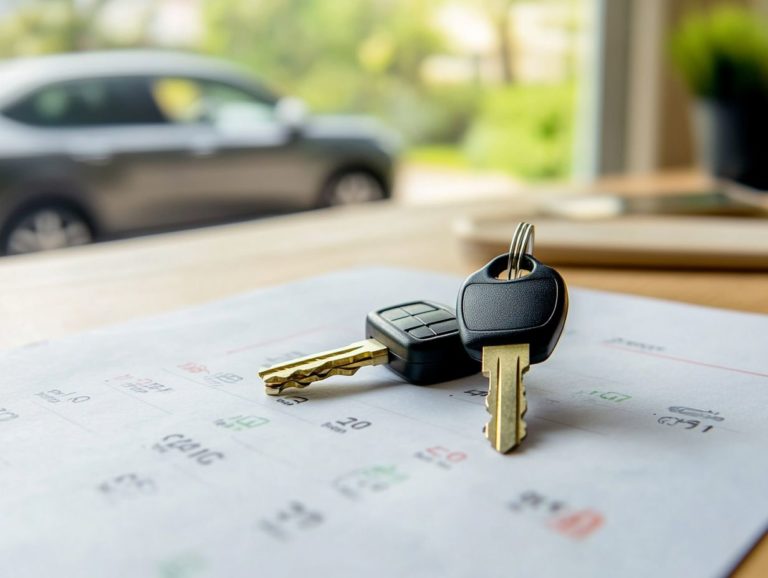How to Evaluate Safety Ratings of New Cars
When considering the purchase of a new car, safety should be at the top of your list. Understanding how to evaluate safety ratings can greatly enhance your ability to protect yourself and your loved ones while on the road.
This guide will delve into the significance of safety ratings, the different types of crash tests, and the best ways to interpret the results. You ll also discover essential safety features and learn effective strategies for researching specific models.
Join in as you explore the critical factors that play a role in selecting the safest car tailored to your needs.
Contents
- Key Takeaways:
- The Importance of Safety Ratings for New Cars
- Understanding Crash Test Ratings
- Other Safety Features to Consider
- Researching Safety Ratings for Specific Models
- Tips for Choosing the Safest Car
- Frequently Asked Questions
- What are safety ratings and why are they important when evaluating new cars?
- How can I find and access safety ratings for specific new cars?
- What are the different types of safety ratings and what do they measure?
- What factors should I consider when evaluating safety ratings for new cars?
- How do I know if a car has good safety ratings?
- Can I solely rely on safety ratings when choosing a new car?
Key Takeaways:

Consider safety ratings when shopping for a new car to prioritize the safety of yourself and your passengers. Don’t just focus on crash test ratings; research what to know about safety ratings and other safety features, such as those that assist drivers, like automatic braking and structural design, for a more comprehensive evaluation.
The Importance of Safety Ratings for New Cars
When considering the purchase of a new vehicle, understanding the importance of safety ratings is essential. These ratings offer invaluable insights into how well a vehicle performs during crash tests and highlight key safety features from automakers that can substantially reduce the risks of collisions.
Organizations like the National Highway Traffic Safety Administration (NHTSA) and the Insurance Institute for Highway Safety (IIHS) lead the charge in establishing these ratings, ensuring you have access to comprehensive information about the advanced safety features and technologies available in passenger cars, SUVs, and pickup trucks.
Why You Should Consider Safety Ratings
Considering safety ratings when selecting a vehicle is essential, as these ratings indicate how well a model can protect occupants during a crash and its effectiveness in avoiding collisions altogether. Don t wait make sure the car you choose is safe for you and your family!
High safety ratings provide substantial advantages, including a significantly reduced risk of accidents and enhanced protection for those on board. Advanced safety technologies, such as Emergency Braking and Lane Keeping Assist, are pivotal in achieving these ratings. They actively work to prevent accidents before they happen.
Take the Volvo XC90 and the Subaru Outback, for instance both have secured top safety marks thanks to their cutting-edge features and sturdy design. When you prioritize safety ratings, you can feel more assured that your chosen vehicle will protect not just you but also your beloved passengers across a range of driving conditions. Start your search today to find the safest car for you!
Understanding Crash Test Ratings
Crash test ratings are essential indicators of a vehicle’s capacity to endure impacts and safeguard its occupants.
Reputable agencies like the NHTSA and EURO NCAP meticulously evaluate these ratings through a series of tests. They use crash-test dummies to replicate real-life scenarios, ensuring that the results reflect the true safety performance of the vehicle.
Types of Crash Tests
There are various types of crash tests, each meticulously designed to evaluate specific aspects of vehicle safety, such as frontal crash tests, side crash tests, and assessments for rollover resistance.
These evaluations are essential for comprehending how a vehicle will perform in real-world scenarios. Frontal crash tests simulate a head-on collision, meticulously examining the structural integrity of the front end along with the effectiveness of seatbelts and airbags. Side crash tests focus on the protection provided to passengers during side impacts, which often pose greater risks. Rollover resistance tests evaluate how likely a vehicle is to flip over during sharp turns or sudden stops.
The ratings from these tests play a pivotal role in shaping consumer decisions, with vehicles like the Honda Accord standing out for frontal protection and the Subaru Ascent earning high accolades for side impact safety.
Start exploring safety ratings now to ensure your next car is the best choice for your peace of mind!
Interpreting Results

Interpreting crash test results is crucial for understanding a vehicle’s safety performance. These ratings come from respected agencies like NHTSA and IIHS.
Examining these ratings, including star ratings and detailed feedback, helps you gauge how different vehicle models perform in crashes. Star ratings typically range from one to five, with higher ratings signaling superior safety features and overall performance in tests.
Qualitative assessments provide valuable context, highlighting each vehicle’s specific strengths and weaknesses. When comparing models, consider both the numerical ratings and the detailed feedback.
This approach ensures you select a vehicle that not only meets your safety expectations but also aligns with your personal needs.
Other Safety Features to Consider
It’s vital to consider other safety features immediately to gain a thorough understanding of a vehicle’s safety capabilities.
Pay special attention to advanced safety technologies and crash avoidance systems developed by automakers. These innovations play a crucial role in enhancing your safety on the road.
Explore Advanced Driver Assistance Systems
Advanced Driver Assistance Systems (ADAS) include innovative safety technologies designed to assist you and elevate your overall vehicle safety. These features include essentials like Emergency Braking and adaptive cruise control.
These systems are pivotal in mitigating risks on the road by providing you with real-time support. For instance, the Emergency Braking feature automatically engages the brakes when it detects a potential collision, significantly lowering the chances of an accident.
Likewise, adaptive cruise control not only maintains your desired speed but also adjusts your vehicle s pace in response to the flow of traffic, ensuring a safer driving experience.
As modern vehicles increasingly incorporate these cutting-edge technologies alongside traditional safety measures like airbags and seatbelts, the collective impact on reducing traffic fatalities and enhancing overall road safety is nothing short of remarkable.
Understand Structural Design and Materials
The structural design and materials in a vehicle significantly influence its safety ratings, ultimately affecting performance in crash testing scenarios.
Innovative manufacturers are increasingly opting for high-strength steel, which delivers superior durability without adding unnecessary weight. This allows vehicles to remain fuel-efficient while enhancing protection.
The incorporation of crumple zones is essential; these meticulously designed areas absorb energy during a collision, significantly reducing the impact on passengers. Take, for example, the Volvo XC90, which showcases advanced structural elements and materials to achieve exceptional crash test results.
Meanwhile, the Tesla Model X employs a distinctive architecture that not only bolsters safety but also elevates performance. These advancements reflect the industry’s unwavering commitment to prioritizing passenger safety while harmonizing modern aesthetics and functionality.
Researching Safety Ratings for Specific Models
Researching safety ratings for specific vehicles is crucial for making smart buying decisions today.
By tapping into reliable information from safety rating agencies and other trusted sources, you empower yourself to choose wisely and ensure your vehicle meets your safety standards.
What safety features are you looking for in your next vehicle?
Where to Find Reliable Information

Finding reliable information on safety ratings is easy when you turn to reputable sources like the National Highway Traffic Safety Administration (NHTSA) and the Insurance Institute for Highway Safety (IIHS). These organizations provide comprehensive vehicle assessments that you can trust.
Both agencies employ rigorous testing methods and extensive data analysis to evaluate vehicle performance in crash tests. This results in highly credible ratings. You can also visit their official websites for detailed reports, comparisons, and safety features of various models.
A plethora of online databases and automotive review platforms have surfaced, offering user-friendly interfaces that allow you to quickly check safety ratings. Make sure to check these trusted sources they’re your best bet for the latest safety updates!
It s essential to prioritize information from established safety rating agencies, as they ensure the accuracy and regular updates you need to stay informed about the latest safety innovations in the automotive industry.
Tips for Choosing the Safest Car
When selecting the safest car, you must evaluate several key factors. Pay attention to vehicle safety ratings and advanced safety features.
Factors to Consider
When selecting a vehicle, take several key factors into account, such as the vehicle’s safety ratings, the inclusion of advanced safety features, and the efficacy of crash avoidance systems.
It’s vital to assess the reliability of data from trusted crash test organizations like NHTSA and IIHS.
Technological advancements, such as automatic emergency braking and lane-keeping assist, significantly bolster safety, making them worth your attention.
The reputation of the automaker is equally important. Established manufacturers typically prioritize safety and invest in cutting-edge innovations.
Ultimately, prioritizing these elements should reflect your personal needs, including your driving habits, family requirements, and budget constraints. This ensures that you make a well-informed decision.
Frequently Asked Questions
What are safety ratings and why are they important when evaluating new cars?
Safety ratings are evaluations of a vehicle’s performance in crash tests conducted by independent organizations. They are important because they provide consumers with information on how well a vehicle could protect its occupants in the event of a crash.
How can I find and access safety ratings for specific new cars?

You can find safety ratings for new cars by visiting the websites of reputable organizations such as NHTSA or IIHS. These organizations conduct regular crash tests and publish their findings online for public access.
What are the different types of safety ratings and what do they measure?
The two most common types of safety ratings are crashworthiness ratings and crash avoidance ratings. Crashworthiness ratings tell you how well a car protects its occupants in a collision, while crash avoidance ratings evaluate a vehicle’s technology and features that can help prevent or mitigate a crash.
What factors should I consider when evaluating safety ratings for new cars?
When evaluating safety ratings, consider the overall score, individual category scores, and the specific tests conducted. To gain a deeper understanding, learn how to interpret car ratings effectively. You should also take into account any additional safety features offered by the vehicle, such as blind spot detection or automatic emergency braking.
How do I know if a car has good safety ratings?
Cars with good safety ratings typically have high overall scores and high scores in individual categories such as frontal and side crash tests. They may also have advanced safety features and technology that can help prevent accidents.
Start your research today! Check out the latest ratings to choose a safer vehicle for you and your family.
Can I solely rely on safety ratings when choosing a new car?
Safety ratings are important, but they aren’t the only factor to consider.
Discover what fits your lifestyle and needs best!
Don’t forget to look into reliability, fuel efficiency, and overall costs.
Make sure you choose a car that excites you!






